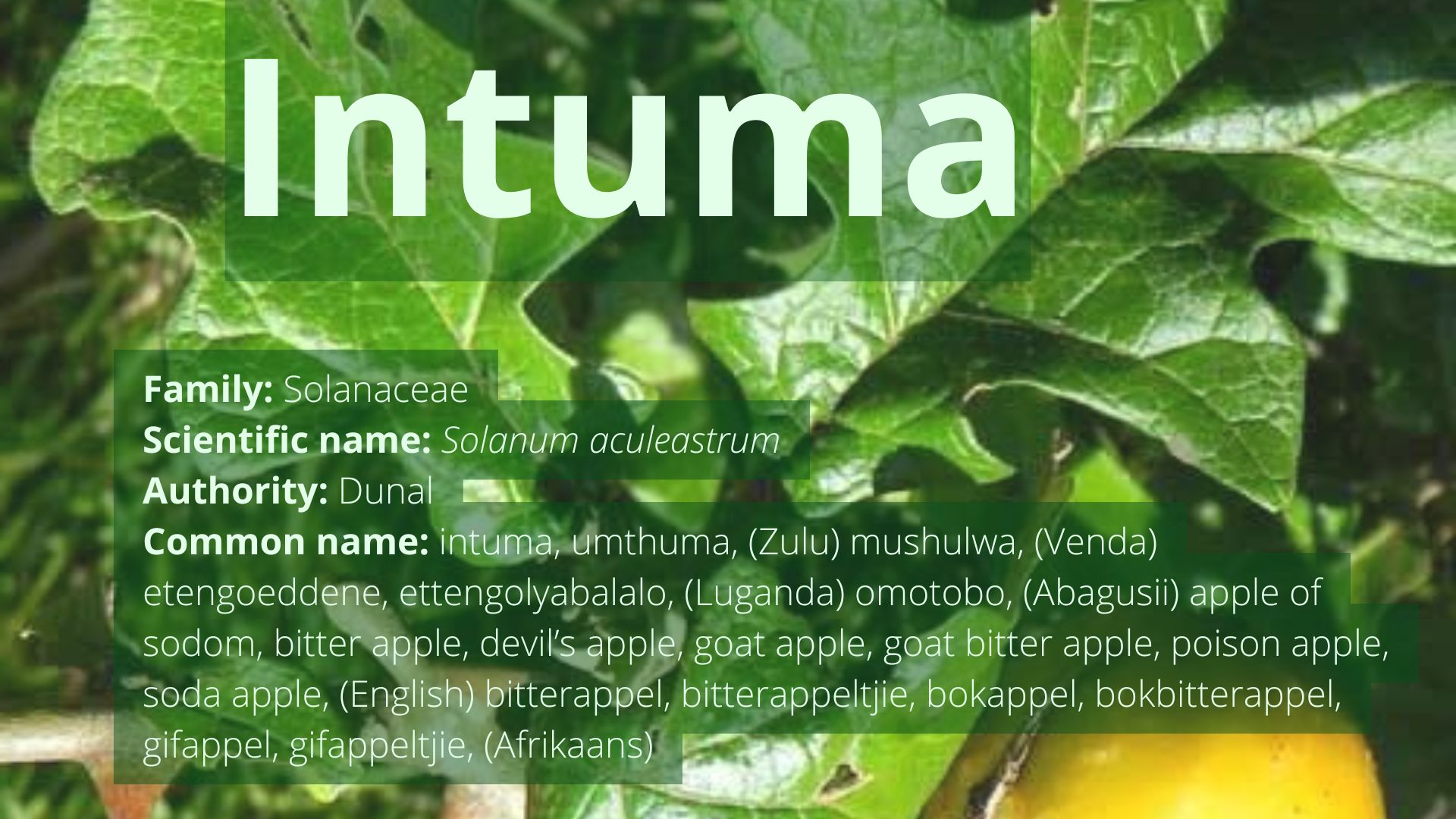Family: Solanaceae
Scientific name: Solanum aculeastrum
Authority: Dunal
Common name: intuma, umthuma, (Zulu) mushulwa, (Venda) etengoeddene, ettengolyabalalo, (Luganda) omotobo, (Abagusii) apple of sodom, bitter apple, devil’s apple, goat apple, goat bitter apple, poison apple, soda apple, (English) bitterappel, bitterappeltjie, bokappel, bokbitterappel, gifappel, gifappeltjie, (Afrikaans)
Description: S. aculeastrum is a thorny multi-branched perennial woody shrub (or small tree) that grows up to 3m and widely distributed in South Africa occurring naturally in forest margins, grassland, and woodland in disturbed places. It has discoloured lobed leaves shiny above with white hairs underneath, shorty tubular white-pale mauve flowers, and lemon-shaped berries that become yellow-green (orange-yellow) when ripe with many seeds in sticky pulp.
The poisonous fruits and leaves have a high saponin content.
Uses:
- The fruits and leaves are used as a soap substitute.
- The liquid of the fruit is used as glue to fix tool handles and joints in musical instruments.
- The fresh, boiled, dried, and charred ripe fruits and leaves are used as a cure for jigger infestations and wounds.
- The charred and powdered fruit is sprinkled over toasted millet grains, which are eaten as an anti-emetic.
- The fruit is used as an anthelmintic for taeniasis, to expel tapeworms.
- The fruit is used for dysentery and burning and itchy defecation.
- The roots and leaves are used for excessive menstrual flow.
- The roots are used to treat an enlarged spleen.
- The roots are used for inflammation.
- The roots are used for epilepsy.
- The plant is used for hedge fencing around homes and gardens.
- The plant is used in initiation ceremonies for young girls.
Reference and further reading:
- Adebola, P.O. and Afolayan, A.J., 2006. Germination responses of Solanum aculeastrum, a medicinal species of the Eastern Cape, South Africa. Seed Science and Technology, 34(3), pp.735-740.
- Amer, A.A., Soliman, A.A., Alshareef, W.A., Mandour, Y.M. and Abdelrahman, M.T., 2024. Biochemical and biological studies of irradiated and non-irradiated extracts of Solanum aculeastrum Dunal fruit. Scientific Reports, 14(1), p.24829.
- Burger, T., Mokoka, T., Fouché, G., Steenkamp, P., Steenkamp, V. and Cordier, W., 2018. Solamargine, a bioactive steroidal alkaloid isolated from Solanum aculeastrum induces non-selective cytotoxicity and P-glycoprotein inhibition. BMC complementary and alternative medicine, 18(1), p.137.
- Bussmann, R.W., Paniagua-Zambrana, N.Y. and Njoroge, G.N., 2020. Solanum aculeastrum Dunal Solanum anguivi Lam. Solanum incanum L. Solanum nigrum L. Solanaceae. In Ethnobotany of the mountain regions of Africa (pp. 1-12). Cham: Springer International Publishing.
- Drewes, F.E. and Van Staden, J., 1995. Aspects of the extraction and purification of solasodine from Solanum aculeastrum tissues. Phytochemical analysis, 6(4), pp.203-206.
- Hikaambo, C.N.A., Chilala, P., Ndubi, F., Mayoka, G., Kampamba, M., Kabuka, R., Chabalenge, B. and Mudenda, S., 2023. Antimicrobial activities of Solanum aculeastrum fruit extract against Escherichia coli, Staphylococcus aureus and Candida albicans: significance of african traditional medicine in combating infections and attaining universal health coverage. Pharmacology & Pharmacy, 14(5), pp.176-188.
- Koduru, S., Grierson, D.S. and Afolayan, A.J., 2006. Antimicrobial Activity of Solanum aculeastrum. Pharmaceutical biology, 44(4), pp.283-286.
- Lye, K. A., Bukenya-Ziraba, R., Tabuti, J.R.S. & Waako, P.J. 2008. Botanical-Medicinal Dictionary for East Africa. Makerere Herbarium Handbook no. 2. Department of Botany, Makerere University, Kampala, Uganda.
- Mabogo, D.E.N. 1990. The ethnobotany of the vhavenda. University of Pretoria.

